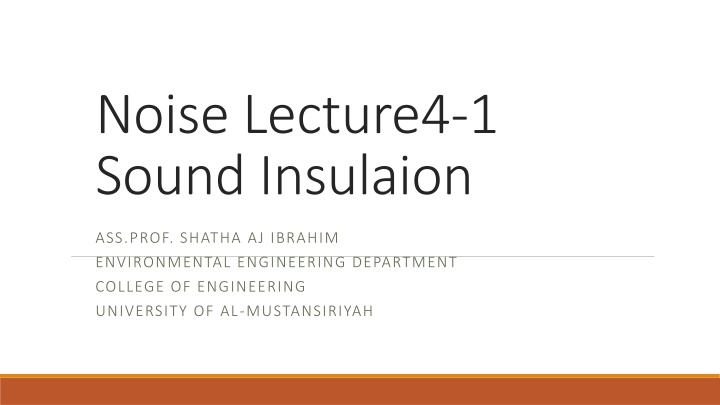
Sound Insulation in Environmental Engineering
Sound insulation plays a crucial role in environmental engineering to reduce airborne and structure-borne sound transmission. This article discusses the concepts of airborne sound, structure-borne sound, and sound insulation through partitions and composite partitions. It explains how sound energy is transmitted and attenuated by solid partitions, and how the mass of a partition affects sound insulation. The calculations and factors influencing sound reduction are also explored in detail.
Download Presentation

Please find below an Image/Link to download the presentation.
The content on the website is provided AS IS for your information and personal use only. It may not be sold, licensed, or shared on other websites without obtaining consent from the author. If you encounter any issues during the download, it is possible that the publisher has removed the file from their server.
You are allowed to download the files provided on this website for personal or commercial use, subject to the condition that they are used lawfully. All files are the property of their respective owners.
The content on the website is provided AS IS for your information and personal use only. It may not be sold, licensed, or shared on other websites without obtaining consent from the author.
E N D
Presentation Transcript
Noise Lecture4-1 Sound Insulaion ASS.PROF. SHATHA AJ IBRAHIM ENVIRONMENTAL ENGINEERING DEPARTMENT COLLEGE OF ENGINEERING UNIVERSITY OF AL-MUSTANSIRIYAH
Airborne Sound: Sound or noise radiated directly from a source, such as a loudspeaker or machine, into the surrounding air. Structure-borne Sound: Sound which reaches the receiver after travelling from the source via a building or machine structure; structure-borne sound travels very efficiently in building, and is more difficult to predict than airborne sound. Sound Insulation: The reduction or attenuation of airborne sound by a solid partition between source and receiver; this may be a building partition (e.g. a floor, wall or ceiling), a screen or barrier or an acoustic enclosure.
4.1 Sound insulation by partitions Sound can be transmitted into a room by some or all of the methods shown in Fig.1 1-Airborne sound in the source room excites the separating partition into vibration which directly radiates the sound into the receiving room. The amount of attenuation will depend upon the frequency of sound, the mass, fixing conditions and thus the resonant frequencies of the partition. 2- Airborne sound in the source room may excite walls other than the separating one into vibration. The energy is then transmitted through the structure and re-radiated by some other partition into the receiving room. 3-Any wall other than the separating one may be excited. The sound is transmitted to the separating wall and the re-radiated by it. 4-Sound energy from the separating partition is radiated into the receiving room by some other wall. Fig.1
.2 Sound insulation by composite partitions The sound reduction of a partition measured in dB will depend upon the proportion of sound energy transmitted. Reduction in dB = 10 log1 t Where t= is the transmission coefficient (the ratio of sound energy transmitted by a partition, or across a boundary, to the sound energy incident upon the partition or the boundary, ? = 1 2??2 ?? where = angular velocity (radians/sec) = 2 f m= mass of the partition /unit area When calculating the sound insulation of a partition consisting of more than one part ( e.g. a 115 mm brick wall with a door) it is first necessary to find the transmission coefficient of each. From this, the average transmission coefficient may be calculated using this formula: tav S= t1 S1+ t2 S2+ .. where tav=average transmission coefficient S= total area of the partition, m2 t1 , t2, .= transmission coefficients of each section. S1 , S2, = area of each part, m2
4.3 The sound insulation depend on mass The insulation from a single partition is approximately Rav= 10+14.5 log m Where Rav= average sound reduction in dB m = mass/ unit area in kg/m2 4.4 The sound insulation by the use of absorbents Sound absorption: 1) the process whereby sound energy is converted into heat, leading to a reduction in sound pressure level. 2) the property of a material which allows it to absorb sound energy like the porous materials Sound absorption coefficient: a measure of the effectiveness of material as sound absorbers, it is the ratio of the sound energy absorbed or transmitted (not reflected) by a surface to the total sound energy incident upon that surface, the value of the coefficient varies from 0 (for very poor absorbers and good reflectors) to 1 (for very good absorbers and poor reflectors).
















